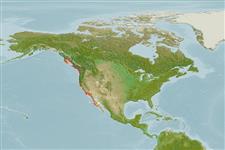Environment: milieu / climate zone / depth range / distribution range
Οικολογία
Θαλασσινό(ά); Υφάλμυρο βενθικό(ς); εύρος βάθους 0 - 2 m (Ref. 96339). Subtropical; 55°N - 22°N, 136°W - 111°W
Eastern Pacific: Rivers Inlet, British Columbia, Canada to Baja California, Mexico.
Μέγεθος / Βάρος / Age
Maturity: Lm ? range ? - 3.4 cm
Max length : 6.4 cm SL αρσενικό/απροσδιόριστο; (Ref. 27436); common length : 4.2 cm TL αρσενικό/απροσδιόριστο; (Ref. 12193); μεγ. αναφερόμενη ηλικία: 3.00 έτη (Ref. 72494)
Short description
Κλείδες προσδιορισμού | Μορφολογία | Μορφομετρία
Ραχιαίες άκανθες (συνολικά) : 4 - 5; Μαλακές ραχιαίες ακτίνες (συνολικά) : 15 - 17; Εδρικές άκανθες: 0; Μαλακές εδρικές ακτίνες: 14 - 17. Caudal rounded.
Inhabits sand or mud bottom. Retreats into shrimp burrows when threatened and at low tide (Ref. 6885). Commonly in estuaries, lagoons and tidal sloughs. Reported to occur in freshwater. Adults feeds on diatoms, green algae, tintinnids, eggs and young of their hosts (Ref. 6885). Positions large food particles near crabs to be torn to smaller pieces (Ref. 6885). Preyed upon by Sebastes, staghorn sculpin, whitespot greenling, and terns (Ref. 6885). Unlike other gobies, it does not build a nest or care for its young (Ref. 2850).
Eschmeyer, W.N., E.S. Herald and H. Hammann, 1983. A field guide to Pacific coast fishes of North America. Boston (MA, USA): Houghton Mifflin Company. xii+336 p. (Ref. 2850)
IUCN Red List Status (Ref. 130435)
Threat to humans
Harmless
Human uses
αλιεία: Εμπορικό(ά); Ενυδρείο: Δημόσια ενυδρεία
Εργαλεία
Special reports
Download XML
Διαδικτυακές πηγές
Estimates based on models
Preferred temperature (Ref.
123201): 9.4 - 18.5, mean 10.8 °C (based on 189 cells).
Phylogenetic diversity index (Ref.
82804): PD
50 = 1.0000 [Uniqueness, from 0.5 = low to 2.0 = high].
Bayesian length-weight: a=0.00977 (0.00442 - 0.02163), b=3.05 (2.86 - 3.24), in cm total length, based on LWR estimates for this (Sub)family-body shape (Ref.
93245).
Τροφικό Επίπεδο (Ref.
69278): 3.1 ±0.42 se; based on food items.
Ελαστικότητα (Ref.
120179): Υψηλό, ελάχιστος χρόνος για διπλασιασμό πληθυσμού < 15 μήνες (tm=1; tmax=2.5).
Fishing Vulnerability (Ref.
59153): Low vulnerability (10 of 100).
